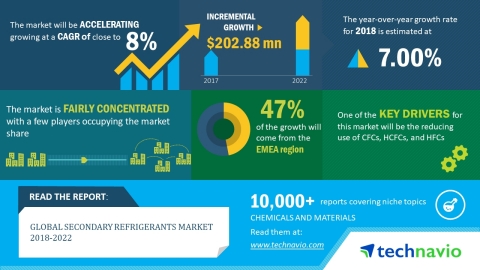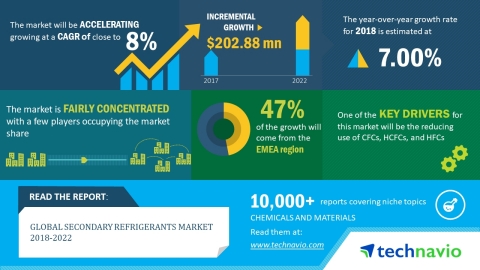LONDON--(BUSINESS WIRE)--Technavio analysts forecast the global secondary refrigerants market to grow at a CAGR of close to 8% during the forecast period, according to their latest market research report.
The development of water-based and bio-based heat transfer fluids is one of the major trends being witnessed in the global secondary refrigerants market 2018-2022. The type of heat transfer fluids significantly impacts the performance, cost, and reliability of solar thermal systems. Thus, manufacturers are developing water-based and bio-based heat transfer fluids for use as secondary refrigerants in various refrigeration systems. Water-based and bio-based heat transfer fluids offer unique technical properties such as excellent thermal stability at high temperature for thermal solar applications and low viscosity at low temperature for cooling applications. Water-based and bio-based heat transfer fluids are eco-friendly and, thus, are preferred over conventional heat transfer fluids. Thus, the advantages of using water-based and bio-based heat transfer fluids as secondary refrigerants are expected to boost the demand for secondary refrigerants.
This report is available at a USD 1,000 discount for a limited time only: View market snapshot before purchasing
According to Technavio analysts, one of the key factors contributing to the growth of the global secondary refrigerants market is the reducing use of CFCs, HCFCs, and HFCs:
Global secondary refrigerants market: Reducing use of CFCs, HCFCs, and HFCs
CFCs, HCFCs, and HFCs are traditional refrigerants used as primary refrigerants. These negatively impact the environment by depleting the earth's ozone layer, which protects the earth from harmful ultraviolet (UV-6) rays generated from the sun. In addition, they increase the temperature in the lower atmosphere of the earth, resulting in global warming. Some of the negative impacts on the environment include - rise in sea levels, loss of habitat and resultant extinction of natural species, frequent heavy rainfall and floods and health risk from insect and water-borne diseases. Thus, owing to the negative effects associated with the use of these refrigerants, manufacturers are shifting toward secondary refrigerants, such as glycol or brine. This has contributed to the overall growth of the global secondary refrigerants market.
According to a senior analyst at Technavio, “With the growth of the processed food market, the food industry is facing challenges in terms of production, storage, and retailing as they have to ensure that the cold chain remains uninterrupted for perishable goods. In addition, they focus on minimizing the carbon footprint of their production and storage activities. Therefore, they prefer natural and secondary refrigerants, which will have a positive impact on the market.”
Global secondary refrigerants market: Segmentation analysis
The global secondary refrigerants market research report provides market segmentation by application (commercial refrigeration, residential refrigeration, heat pumps, and air conditioning) and by region (the Americas, EMEA, and APAC). It provides an in-depth analysis of the prominent factors influencing the market, including drivers, opportunities, trends, and industry-specific challenges.
The EMEA region held the largest share of the market in 2017, accounting for close to 43% share, followed by APAC and Americas respectively. During the forecast period, the EMEA region is expected to continue dominating the global secondary refrigerants market and register the highest incremental growth.
Looking for more information on this market? Request a free sample report
Technavio’s sample reports are free of charge and contain multiple sections of the report such as the market size and forecast, drivers, challenges, trends, and more.
Some of the key topics covered in the report include:
Market Landscape
- Market ecosystem
- Market characteristics
- Market segmentation analysis
Market Sizing
- Market definition
- Market size and forecast
Five Forces Analysis
Market Segmentation
Geographical Segmentation
- Regional comparison
- Key leading countries
Market Drivers
Market Challenges
Market Trends
Vendor Landscape
- Vendors covered
- Vendor classification
- Market positioning of vendors
- Competitive scenario
About Technavio
Technavio is a leading global technology research and advisory company. Their research and analysis focuses on emerging market trends and provides actionable insights to help businesses identify market opportunities and develop effective strategies to optimize their market positions.
With over 500 specialized analysts, Technavio’s report library consists of more than 10,000 reports and counting, covering 800 technologies, spanning across 50 countries. Their client base consists of enterprises of all sizes, including more than 100 Fortune 500 companies. This growing client base relies on Technavio’s comprehensive coverage, extensive research, and actionable market insights to identify opportunities in existing and potential markets and assess their competitive positions within changing market scenarios.
If you are interested in more information, please contact our media team at media@technavio.com.




